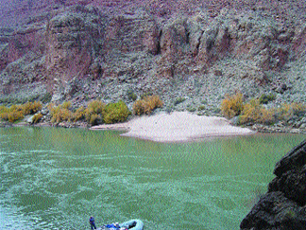| A sandbar is a deposit of sand along the shore of a river. The Colorado River carries with it a steady quantity of sand, some of which settles along the bottom. Occasional floods stir up the sand on the bottom and spread it along the river's edges, creating sandbars. Sandbars and other sedimentary environments provide homes to plants, land animals, and fish native to the Colorado River. |
| |
Glen Canyon Dam on the Colorado River was completed in 1963. The change in the natural flow of the river, including periodic floods, to a much more controlled river has resulted in a decline of sandbars. As the sandbars dwindled, the native humpback chub had fewer places to live and the population declined. It is now an endangered species. | ||
Sandbars have shrunk or disappeared along the Colorado River for two basic reasons. One: The dam traps much of the sand that once came down the river. Two: The dam carefully controls the flow of water, making floods a thing of the past, and allowing erosion to dominate the River. | ||
The dam's particular method of operation has worsened the sandbar shrinkage. Glen Canyon Dam is always releasing some water into the river to generate hydroelectric power for such cities as Phoenix and Las Vegas. Whenever people in those cities crank up their air conditioners, dam operators release more water to make extra electricity. That style of dam operation makes the level of the river go up and down like a yoyo every day. When the level is up, the sand beaches get waterlogged. When the level is down, the wet, heavy sand crumbles into the river. |
ENGINEERED FLOOD
Scientists thought they could restore the sandbars by engineering floods. In March 1996, scientists from the Bureau of Reclamation, which operates the dam, sent 1,275 cubic meters (45,000 cubic feet) of water gushing past the dam every second for a week. That's two to three times more water than usual. The scientists had hoped that the flood would rebuild some of the sandbars. Within a year, the rebuilt bars had mostly disappeared. "Later, we discovered that the experiment actually removed sand," said Dennis Kubly, a Bureau of Reclamation scientist.
Based on the results of the first "high flow experiment," scientists waited until the tributaries downstream of the dam had carried a lot of new sand into the Colorado. That way the experimental flood would have more sand with which to build sandbars. During the two months before the experiment, flows were kept low so that the sand in the river channel wouldn't be washed away early. Scientists took photographs of sand bars and used laser beams to measure sediment in the water. In the weeks leading up to the flood, the Paria River, a downstream tributary, dumped tons of sand and silt into the Colorado River.
Finally, on November 21, 2004, the floodgates were opened and for two and a half days water flowed at a rate of 1,160 cubic meters (41,000 cubic feet) per second through the dam. Ted Melis, a geologist with the U.S. Geological Survey, reported afterward that sandbars looked better for at least 40 miles downstream. "But below mile 40, it wasn't as consistent," he said. Melis says he and other scientists won't draw any conclusions until the middle of 2006.
Scott Wright, a hydrologist at the U.S. Geological Survey in Flagstaff, Ariz., says he saw very fine sediment — clay and silt — in the first mad rush of the river, which was then replaced by larger sand grains as the flow continued. A visual check shows that some beaches did get rebuilt along the river, at least for now. "Based on what happened in 1996 and the preliminary photos I've seen, I believe that [the flood] will build some beaches," Wright says. "The question that is more important is how long those will last?"
SERIOUS SCIENCE
Some people wish the Glen Canyon Dam had never been built. Others say the flood experiment was a waste of a natural resource because it released water that could have been used to generate electricity. "Humans have different outlooks on what rivers are for," said Kubly. "It's all about a balancing act." Kubly hopes that the 2004 flood experiment will lead to a better solution for everyone. Glen Canyon Dam operates differently from the way it did in the years just after it was built. It wasn't managed with the environment as a priority then, but it is now. "It embraces science more seriously," he said.

